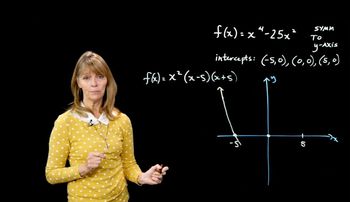Table of contents
- 0. Review of Algebra4h 16m
- 1. Equations & Inequalities3h 18m
- 2. Graphs of Equations43m
- 3. Functions2h 17m
- 4. Polynomial Functions1h 44m
- 5. Rational Functions1h 23m
- 6. Exponential & Logarithmic Functions2h 28m
- 7. Systems of Equations & Matrices4h 6m
- 8. Conic Sections2h 23m
- 9. Sequences, Series, & Induction1h 19m
- 10. Combinatorics & Probability1h 45m
4. Polynomial Functions
Dividing Polynomials
Problem 102
Textbook Question
Perform each division. See Examples 9 and 10. (10x^3+11x^2-2x+3)/(5x+3)
 Verified step by step guidance
Verified step by step guidance1
Identify the dividend as \(10x^3 + 11x^2 - 2x + 3\) and the divisor as \(5x + 3\).
Set up the long division by writing \(10x^3 + 11x^2 - 2x + 3\) under the division symbol and \(5x + 3\) outside.
Divide the first term of the dividend \(10x^3\) by the first term of the divisor \(5x\) to get the first term of the quotient, which is \(2x^2\).
Multiply the entire divisor \(5x + 3\) by \(2x^2\) and subtract the result from the dividend to find the new dividend.
Repeat the process with the new dividend, dividing the first term by \(5x\), multiplying, and subtracting, until the degree of the remainder is less than the degree of the divisor.
Recommended similar problem, with video answer:
 Verified Solution
Verified SolutionThis video solution was recommended by our tutors as helpful for the problem above
Video duration:
5mPlay a video:
Was this helpful?
Key Concepts
Here are the essential concepts you must grasp in order to answer the question correctly.
Polynomial Division
Polynomial division is a method used to divide one polynomial by another, similar to long division with numbers. The process involves dividing the leading term of the dividend by the leading term of the divisor, multiplying the entire divisor by this result, and subtracting it from the dividend. This is repeated until the degree of the remainder is less than the degree of the divisor.
Recommended video:
Guided course

Introduction to Polynomials
Synthetic Division
Synthetic division is a simplified form of polynomial division that is particularly useful when dividing by linear factors. It involves using the coefficients of the polynomial and a specific value (the root of the divisor) to perform the division in a more compact form. This method is faster and less cumbersome than traditional polynomial long division, especially for higher-degree polynomials.
Recommended video:

Higher Powers of i
Remainder Theorem
The Remainder Theorem states that when a polynomial f(x) is divided by a linear divisor of the form (x - c), the remainder of this division is equal to f(c). This theorem provides a quick way to evaluate the remainder without performing the full division, and it is particularly useful in polynomial division problems to check the accuracy of the results.
Recommended video:

Higher Powers of i
Related Videos
Related Practice

